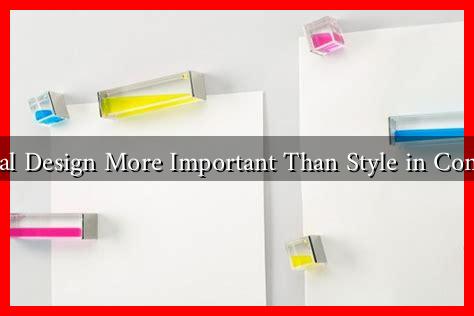-
Table of Contents
Is Functional Design More Important Than Style in Contemporary Design?
In the ever-evolving world of design, the debate between functionality and style remains a hot topic. As contemporary design continues to push boundaries, the question arises: is functional design more important than style? This article delves into the significance of both elements, exploring their roles in various fields such as architecture, product design, and graphic design.
The Essence of Functional Design
Functional design prioritizes usability and practicality. It focuses on how a product or space serves its intended purpose, ensuring that it meets the needs of its users. The principles of functional design can be summarized as follows:
- Usability: The design should be easy to use and understand.
- Accessibility: It should cater to a diverse range of users, including those with disabilities.
- Efficiency: The design should facilitate tasks and minimize wasted time and resources.
- Durability: Functional designs often prioritize materials and construction methods that ensure longevity.
One notable example of functional design is the iPhone. Apple’s smartphone revolutionized the mobile industry by combining sleek aesthetics with intuitive functionality. The user interface is designed to be simple and accessible, allowing users to navigate effortlessly. This balance of form and function has contributed to Apple’s success, demonstrating that functional design can indeed be stylish.
The Allure of Style
While functionality is crucial, style plays an equally important role in design. Style encompasses the aesthetic appeal and emotional resonance of a product or space. It can influence consumer behavior and brand perception significantly. Key aspects of style include:
- Aesthetic Appeal: The visual elements that attract users.
- Brand Identity: Style can communicate a brand’s values and personality.
- Emotional Connection: A well-styled design can evoke feelings and create memorable experiences.
Consider the case of luxury fashion brands like Gucci or Chanel. Their products are not only functional but also serve as status symbols. The intricate designs and high-quality materials create an emotional connection with consumers, often leading to brand loyalty that transcends mere functionality.
The Balance Between Functionality and Style
In contemporary design, the most successful products and spaces often find a harmonious balance between functionality and style. A purely functional design may lack appeal, while a design focused solely on aesthetics may fail to serve its purpose effectively. Here are some examples of this balance:
- Modern Architecture: Buildings like the Sydney Opera House showcase stunning aesthetics while serving as functional performance venues.
- Furniture Design: Brands like IKEA emphasize both style and functionality, offering products that are visually appealing and practical for everyday use.
- Automotive Design: Tesla’s electric vehicles combine sleek, modern aesthetics with cutting-edge technology and functionality.
Statistics and Trends
Recent studies indicate that consumers increasingly value functionality in their purchasing decisions. According to a survey by Statista, 70% of respondents stated that functionality is more important than style when choosing products. This trend is particularly evident in the tech industry, where users prioritize performance and usability over flashy designs.
Conclusion: The Future of Design
In conclusion, while functional design is undeniably crucial in contemporary design, style should not be overlooked. The most effective designs are those that seamlessly integrate both elements, creating products and spaces that are not only practical but also visually appealing. As consumer preferences continue to evolve, designers must strive to find the right balance between functionality and style to meet the demands of a diverse audience.
Ultimately, the question of whether functional design is more important than style may not have a definitive answer. Instead, it highlights the need for a holistic approach to design that values both aspects equally, ensuring that the end product resonates with users on multiple levels.

